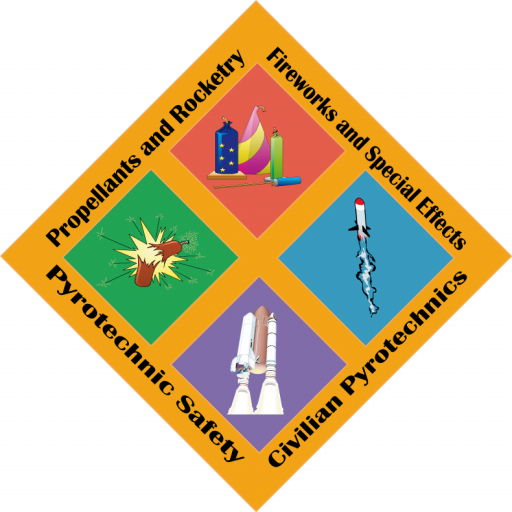K.L. and B.J Kosanke Fire sculptures are not a true pyrotechnic effect, being produced simply by the burning of a liquid fuel in air. Nonetheless their use can contribute rather nicely to firework displays that include ground effects. Fire sculptures form continuous images in yellow fire that burn for 10 minutes or more. This is …
Continue reading Fire Sculptures Using FireRope
Category:Books – Kosanke Articles
Selected Pyrotechnic Publications of KL and BJ Kosanke
Pyrotechnic Accelerants
K.L. Kosanke Conventional accelerants used in arson crimes, such as gasoline, readily burn in air producing flame temperatures of about 3000 °F. Yet these accelerants generally lack the ability to produce major involvements in short times. This is because, like most combustion reactions, they must rely on a continuing supply of air to provide the needed …
Continue reading Pyrotechnic Accelerants
Computer Modeling of Aerial Shell Ballistics
K.L. and B.J Kosanke ABSTRACT: If one has a reasonably accurate computer model, it is usually appropriate (cheaper and faster) to rely primarily on modeled results, supplemented with limited experimental results. The case of aerial shell ballistics is no exception. The mathematical basis for such a ballistics model is derived, and the simplifications and assumptions …
Continue reading Computer Modeling of Aerial Shell Ballistics
Aerial Shell Drift Effects
K.L. and B.J Kosanke ABSTRACT: A prime consideration in determining separation distance requirements for aerial fireworks displays is where fallout of dangerous debris is likely to occur. Certainly the most dangerous single piece of fallout is a dud aerial shell. Thus it is important to have knowledge of where duds may fall during typical displays. …
Continue reading Aerial Shell Drift Effects
Repeat Firing from HDPE Mortars
K.L. and B.J Kosanke ABSTRACT: High Density Polyethylene (HDPE) mortars are beginning to find wide use because of their desirable characteristics. They are relatively inexpensive, lightweight, have a long service life, and some consider them to be among the safest mortars presently in use. Initially HDPE mortars were only recommended for use in electrically fired …
Continue reading Repeat Firing from HDPE Mortars
Dautriche – Shock Tube Measurement of High Propagation Rates in Pyrotechnic Materials
K.L. and B.J Kosanke Introduction: There are times when it is of interest to measure propagation rates in highly energetic pyrotechnic materials, such as flash powder. These rates tend to range from less than 1000 to about 5000 feet per second. Conventional means of making such velocity of propagation (VOP) measurements involve the application of …
Continue reading Dautriche – Shock Tube Measurement of High Propagation Rates in Pyrotechnic Materials
Parallel and Propagative Burning
K.L. and B.J Kosanke Introduction: In effect, there are two basic mechanisms for pyrotechnic burning. One, which is primarily burning inward, perpendicular to the burning surface, and one in which accelerated burning along surfaces is most important. These can be termed “parallel” and “propagative” burning, and the same pyrotechnic material can manifest radically different burn …
Continue reading Parallel and Propagative Burning
Production of Benzoate Color Agents
K.L. and B.J Kosanke The use of copper(II) benzoate as a blue color agent was discussed by Bleser.1 In large part, the endorsement for its use is based on its ability to serve as both color agent (copper) and fuel (benzoate). There is something to be said for this approach. For example, consider a color …
Continue reading Production of Benzoate Color Agents
A Collection of Star Formulations
K.L. and B.J Kosanke At one time, we were engaged in the commercial manufacture of stars. During that time we assembled (developed, borrowed or modified) a series of star formulations. It was felt that the formulations were reasonably safe and cost effective, while at the same time, performed well (relatively easy ignition and fairly good …
Continue reading A Collection of Star Formulations
Pyrotechnic Fuse Burn Rates
K.L. and B.J. Kosanke Over the years, we have had occasion to work with a fairly large number of different fuse products. One of the more important characteristics of a pyrotechnic fuse is its burn rate, but often that is not specified by the supplier. Thus, when we have had a large enough supply of …
Continue reading Pyrotechnic Fuse Burn Rates
